The celebration of Christ’s resurrection continues on the Second Sunday of Easter with Divine Mercy Sunday, which recognizes that God’s love and mercy endure forever and overcome any sin that separates us from him. In the 1930s, Jesus appeared to St. Faustina Kowalska, and directed her to promote his divine mercy worldwide. Divine Mercy Sunday was decreed by the Vatican on May 1, 2000, just five days after St. John Paul II canonized St. Faustina who recorded her visions of the risen Lord with two rays of light and the words “Jesus, I trust in you.”
St. Faustina, a poorly educated daughter of a humble Polish family, kept a 600-page diary of the apparitions she claimed continued for years. Her entries focus on God’s mercy, the call to accept God’s mercy and to be merciful, the need for conversion, and the call to trust in Jesus. It had been Jesus’ own wish, she wrote, to establish a feast day: “I [Jesus] desire that the Feast of Mercy be a refuge and shelter for all souls. . . . I am giving them the last hope of salvation; that is, the Feast of My Mercy.”
We celebrate Divine Mercy Sunday with its novena, the Chaplet of the Divine Mercy (a series of prayers organized similarly to a rosary), the Hour of Great Mercy (a time of prayer traditionally celebrated at 3 p.m.), and the plenary indulgence granted to those who receive the Eucharist and celebrate reconciliation on Divine Mercy Sunday. The celebration of Divine Mercy Sunday is an opportunity to reflect on the theme of how God’s mercy can overcome sin and face the difficulties and trials of life.
This information taken from the U.S. Catholic website.


